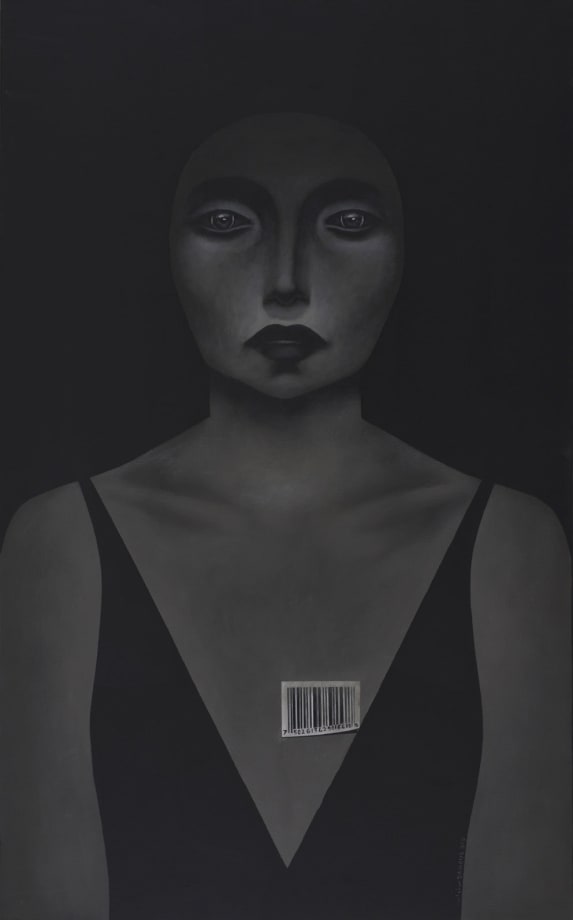The second presentation of Safwan Dahoul's latest body of work, Still Dreaming, highlights a selection of paintings from the artist’s 2018 solo exhibition at Ayyam Gallery Dubai (DIFC). Since the late 1980s, Dahoul’s ongoing Dream series has explored the physical and psychological effects of alienation, solitude, and longing that punctuate the human experience at various stages in life. Partly autobiographical, this seminal body of work uses the formal properties of painting to recreate the subconscious sense of enclosure that surfaces during times of crisis, whether in the event of mourning, estrangement, or political conflict. In his newest works, with the aptly titled exhibition Still Dreaming, the artist continues this exploration, however this time posing the question: Are we still dreaming?
Dahoul explores the nostalgia of home while trying to depict a representation of both what he sees and feels. The exhibition features two large paintings and 16 identically sized works, 120 x 76 cm. In the 16 works, Dahoul’s recurring female protagonist is painted at the centre of the canvas, almost identical in each painting. She sits in precisely the same position, facing the viewer straight on. Each painting, different to the other, is defined by the placement of various objects on the figures chest, that seem to deepen the state of her disaffection, as even the familiar becomes a trigger of distress. The figure is sometimes vacant-eyed, other times more expressive, with minimised physicality. The female’s eyes are lauded with emotion; her lips are slightly parted, seemingly caught in the moment of deciding whether to speak or to remain silent. The works echo of a deafening silence that paralyses the viewer in front of them.
The female protagonist is an embodiment of this exploration, sometimes a reflection of reality, other times a reflection of the artist’s own emotions. In Dream 160 (2018) the artist explains that the added element of a tear down the figures chest was one of the simplest to carry out technically, however, emotionally one of the most difficult.
Using the repetition of this female figure, Dahoul explores the notion of creating infinite iterations of the same thing. Portraying one figure, while creating visibly dissimilar works with slight changes, the artist draws the viewer to each work differently, each invoking a different emotion.
In these works Dahoul continues to isolate his figure further, releasing her from darkened cityscapes and barren landscapes, however keeping her within a dark background. The meaning of the artist’s inverted colour scheme is left open to interpretation. The heavy usage of black and a darker grey scale can be seen to create a certain depth in the painting, a sense of an infinite background behind the figure and a large space that holds something the viewer cannot see, but can only sense. Time and space are unbroken, continuing from one painting to the next, each composition holds a visible sense of melancholy.
About the Artist
As one of the foremost painters in the Arab world, Safwan Dahoul has repeatedly demonstrated how contemporary modes of figuration can describe the psychic terrain of a region that is in constant flux.
Born in 1961 in Hama, Syria, Dahoul was initially trained by leading modernists at the Faculty of Fine Arts, University of Damascus before travelling to Belgium, where he earned a doctorate from the Higher Institute of Plastic Arts in Mons. Upon returning to
Syria, he began teaching at the Faculty of Fine Arts and was a prominent member of the Damascus art scene. In the span of a decade, Dahoul nurtured a new generation of artists as an active mentor whose evolving aesthetic often ignited new directions in painting. Given the trajectory and status of his painting style, Dahoul’s career is regarded as a crucial link between modern and contemporary Arab art.
Dahoul’s paintings are held in numerous private and public collections, including the Institut du Monde Arabe, Paris; Barjeel Art Foundation, Sharjah; National Museum, Damascus; The Samawi Collection, Dubai; The Farjam Collection, Dubai; the Arab Fund for Economic and Social Development, Kuwait. Recently, he has participated in solo and group exhibitions at Ayyam Gallery 11 Alserkal Avenue, Dubai (2017, 2016); Samsung Blue Square and Busan Museum of Art, South Korea (2014); Ayyam Gallery DIFC, Dubai (2014, 2011); Ayyam Gallery Beirut (2014); Ayyam Gallery London (2013); Edge of Arabia, London (2013); and Institut du Monde Arabe, Paris (2012).

